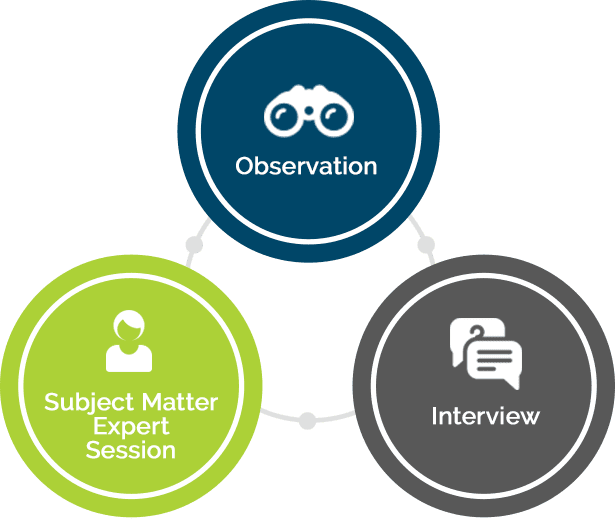WIN Job Analysis Approach
The WIN Job Analysis Process involves in-depth analysis of the job by subject matter experts to make a reasoned determination of job tasks, ranking of task importance, and identification of the WIN Learning foundational skill areas and skill levels required to successfully perform the job. The process helps in finding out what a particular job requires and what skills a prospective worker needs to possess or develop. It also helps in determining particulars about a job including job summary, duties involved, machines, tools, equipment, and materials to be used by the existing or potential employee.
The WIN Job Analysis Process is not limited to determination of these factors only. It also extends to finding out the necessary soft skills needed to succeed on the job. These include communicating effectively, conveying professionalism, promoting teamwork and collaboration, and thinking critically and solving problems.


The WIN Job Analysis Process was developed by job analysts with more than 50 years of practical experience in the workforce development field. The process design considered multiple existing job analysis models, interviews with human resource professionals from a variety of industry sectors, the personal experience of practitioners, feedback from educators using job analysis tools in an academic environment, and meetings and focus group sessions with employers that had experience as a participant with job analysis with their existing or a former employer.

Observation Method
A job analyst observes an employee and records a sampling of performed tasks requiring the math, reading, and data analysis skills. As part of the WIN Learning model, direct observation of the tasks performed as well as the skill areas needed to perform the task, e.g., a math calculation to determine square footage, will be documented by the job analyst.
Interview Method
During the course of the observations, the job analyst interviews the worker performing their job tasks to be certain to understand why a task is performed and, as importantly, if the task requires one of the WIN Learning skills to perform the task. This method helps the job analyst engage the worker performing the task to get a clearer understanding of how a skill area relates to the task.
Subject Matter Expert Session
After the observation and interview segments of the process, the job analyst convenes a group of subject matter experts (SMEs), employees with experience performing the job that is being analyzed. Selection of the SMEs is most critical, in that these employees must be both experienced in performing the job tasks as well as capable of working collaboratively with others to thoroughly analyze the job tasks and make skill area and skill level determinations for entry into the job. The SMEs also rank the importance of the tasks during these sessions.
The WIN Job Analysis process is designed to determine what WIN Learning skill areas and skill levels are required for entry into the job being analyzed, and what soft skills are necessary to increase the applicant’s likelihood of success. It is a systematic exploration, study and recording of the responsibilities, duties, skills, and ability requirements of a specific job. It also involves determining the relative importance of the tasks for a given job. The process measures the extent to which the WIN Learning foundational academic skill areas of math, reading, and data analysis are related to job tasks performed by employees in any job category and in any industry sector. When all three, or any combination, of the foundational skills are determined to be required, the employer's subject matter experts, using the WIN Job Analysis process, will identify the skill levels needed to successfully perform the job.
The WIN Job Analysis process includes a separate methodology for investigating the relationship of specific soft skills that an employer’s subject matter experts determine are required to gain and retain employment with the employer. Soft skills, for many jobs, are considered by employers to be more important than other, so-called hard skills. According to one writer, “When asked, recruiters say that screening candidates for soft skills is one of the top areas they want to learn more about. That’s because soft skills (think leadership, relationship building, communications, adaptability, strategic thinking, learning and interpersonal skills) take up to 25% of the skills required to do the job and to be a great teammate. Unfortunately, these skills are arguably the most difficult to assess in a candidate.” (Dr. John Sullivan, July 27, 2017; LinkedIn)
WIN’s Job Analysis process is a comprehensive job analysis process that can help employers source the right candidates, set appropriate selection standards, and hire and advance the most suitable individual for the job.
Hire & Retain Quality
WIN Learning partners with organizations and employers to determine the nexus between employer job tasks and the skills required to get and retain employment.
The WIN Learning Credentials / Assessments are based on a compilation of prevailing employer-focused research including, but not limited to, the U.S. Department of Labor Survey of Necessary and Comprehensive Skills (SCANS); U.S. Department of Labor Building Blocks Competency Model (Tiers 1-3); U.S. Department of Education Employability Skills Framework; National Network of Business and Industry Associations Common Employability Skills; and Center for Literacy, Education & Employment, Equipped for the Future standards. The assessments are criterion-referenced against an absolute standard or criterion for performance. Thus, the assessments measure mastery of specific learning objectives rather than comparing an individual’s scores to the performance of other test takers.

